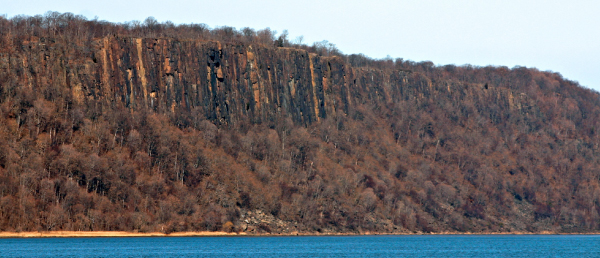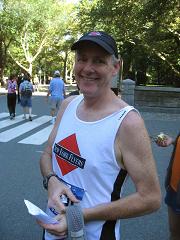 Today was the ING NYC Marathon Tune-Up, and 18 mile race designed to help runners gauge their readiness for the marathon.
Today was the ING NYC Marathon Tune-Up, and 18 mile race designed to help runners gauge their readiness for the marathon.In order to do this run, I had to skip the Flyers 20 mile Tri-Boro run, a great sounding event set up by my friend GW. The Flyers run would have been great socially, and it would have exposed me to some of the marathon course, but I imagined it would involve running on sidewalks, dealing with traffic, and generally be focused less on pace than just getting in a solid long run.
Because I was still not sure what pace I wanted to target for the marathon, I decided on the Tune Up, which would be a timed event in a controlled environment. I decided to try out my most ambitious marathon goal pace, and see how it felt after 18 miles.
As I approached the East Meadow at around 6:30 AM for the 7:00 AM start, I saw a number of runners jogging the other way. I soon found out that the NYRR was not having the usual number (and timing chip) pickup at the start, but rather at the NYRR headquarters. It looked like a lot of runners were going to get in an quick extra mile or more this morning, running there and back. Fortunately, I already had my number, thanks to my friend KH, who had picked it up for me when she was getting her kids' numbers for the 5th Avenue Mile. Hopefully everyone made it to the start on time.
Before the race started, it was clear that the vibe was going to be different from other races. My sense was that folks were there for the same reason that I was. Yes, they would try to go fast, but not push as in a normal race. Folks had their eyes on the prize -- the Marathon. This was a chance to get a sense for their readiness, and develop their race plan.
The race began over the Great Hill, and I fell right into pace. On the West Side, I saw a large group of Team For Kids runners gathering, and I remembered that they were joining the Flyers for the group run I mentioned earlier. Soon after that we started passing Flyers that were running the other way toward the meet point. Running in the opposite direction from a race is a common way for runners to be spectators, and these folks were looking out for team mates to cheer on. Over the next half mile, I greeted so many folks, that I imagined it might be starting to irritate the racers around me. Have I mentioned that the Flyers rule?
At around mile 5, Flyer ST caught up with me and said hello. We chatted a bit about her recent trip to Italy (she had just gotten back the day before!). After a mile or so she said "well, I'm probably holding you back..." (yeah, right). Of course, the truth was the opposite and with my encouragement, she moved on.
One thing I've been working on is taking in fluids on the run. I've finally got the hang of it, using the grab, dump, pinch and suck approach. That is - grab a cup, dump some of the contents if it has more than I want, pinch off the top of the cup so that only an inch or two on one end is open, and then suck out a swallow as you would from a sports bottle. Using this method
 , I can take in a lot without stopping, choking, or holding my breath. During this race, I had plenty of chance to practice, and it seemed to be working well.
, I can take in a lot without stopping, choking, or holding my breath. During this race, I had plenty of chance to practice, and it seemed to be working well.Around mile 7, I decided to go for a GU. In this area I could still use some practice. A GU is a small packet of concentrated.... well, gew, that is supposed to give you energy to make the long distance. I timed it such that I would eat the gel just before I hit a water station, so that I could wash it down. I reached back into the zippered back pocket of my shorts, where I had stashed two gels and a 20 dollar bill (mad money). Well, you can probably finish this story without my help. I came out with one gel in my hand, but the other gel and the money went flying. If you have ever been in an NYRR race, you know that the last thing you want to do is double back into the flow of traffic. If it had just been the GU, I would have left it. The 20 bucks though, I needed that cab fare just in case. Fortunately, a lot of folks saw the money fly, and spoke up. People were generally alerted that something was up, and I was able to retrieve my valuables with out getting run over.
To keep pace on this run, I decided to try a new approach with my Garmin GPS. Instead of watching my mile times and total time, I set it up to highlight my average pace. This way I could really see how I was doing without any calculations mid run. I knew it would be all over the place at first, so I didn't look at it until I had gone several miles. At that point it would move by a second every now and then, mostly over the big hills. Later in the race, as my current pace affected the average less, it hardly moved at all. I am very pleased with this approach. One problem I've had with the GPS, is that it consistently tells me that I've gone farther than the NYRR measurements. This time, for example, by the end of the race, my GPS indicated that I had gone 18.26 miles, more than a quarter mile farther than the official race distance. This meant a mis measurement of 6 seconds per mile. I kept my average pace at 6 seconds faster than my goal, and I hit it spot on at the end of the race.
I will probably use this average pace approach at the marathon. I keeps things in perspective. How much of a hit do you take if you slow down for a water stop or a hill? The average pace will give me flexibility, but also let me know if I'm falling behind.
After the race, I tried to figure out what I had learned. Would this be a good marathon pace? It didn't kill me to do the 18 miles at that pace, but it would have been tough to maintain it for another 8.2. On the plus side, it was a much more hilly18 than the first 18 of the marathon. Also, I will have a few weeks of taper and the excitement of the marathon on my side. And lets not forget that I have two whole more weeks of training before the taper!
Yep, if the weather is good, and I'm feeling froggy, I may just give it a go.





















